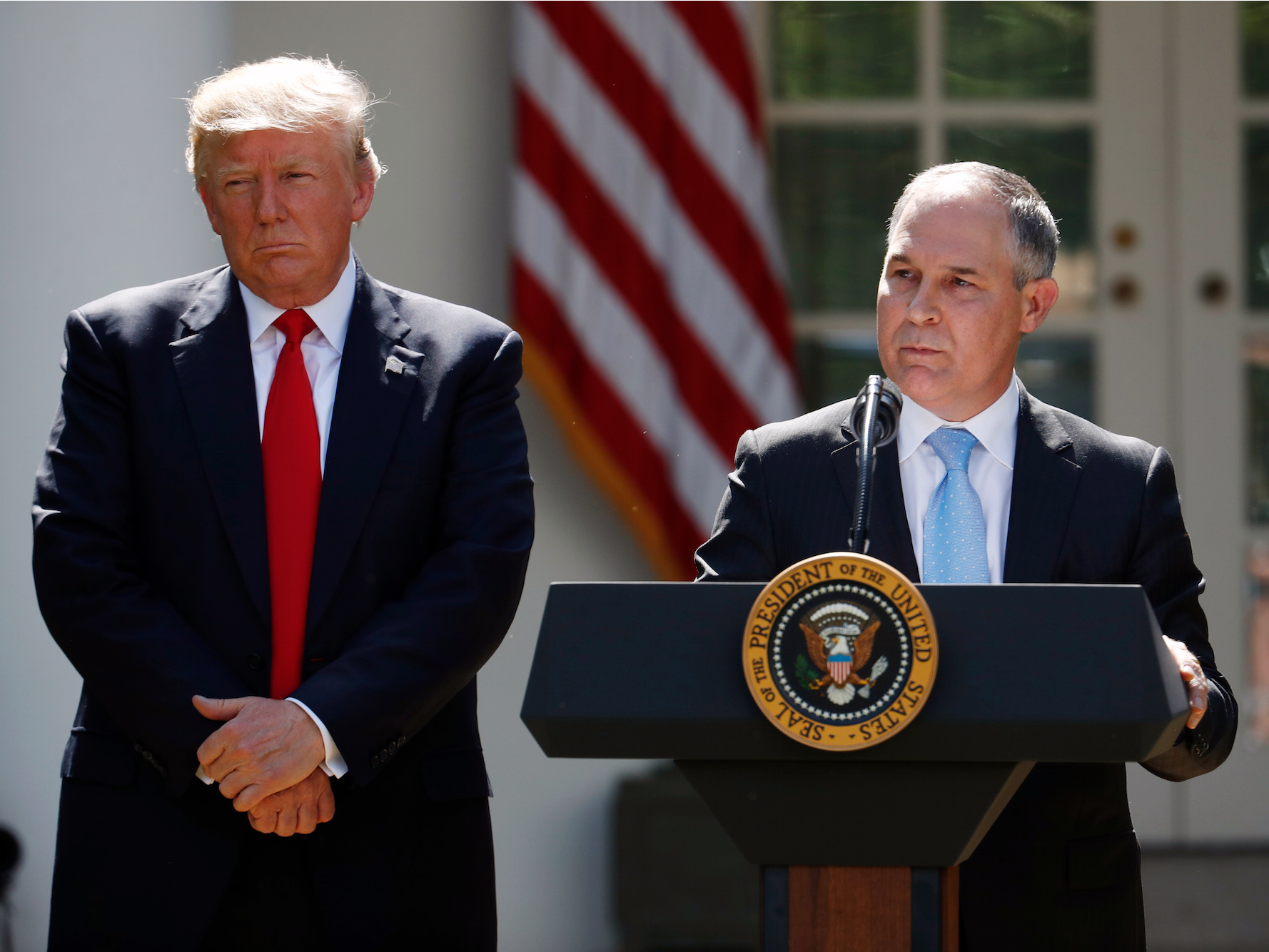 President Donald Trump listens as EPA Administrator Scott Pruitt speaks about the U.S. role in the Paris climate change accord in the Rose Garden of the White House in Washington.Associated Press/Pablo Martinez Monsivais
President Donald Trump listens as EPA Administrator Scott Pruitt speaks about the U.S. role in the Paris climate change accord in the Rose Garden of the White House in Washington.Associated Press/Pablo Martinez Monsivais
- The Trump administration’s efforts to reverse Obama-era policies on climate change face limits.
- Advances in US energy markets have sharply lowered production costs associated with cleaner energy sources such as natural gas, wind and solar.
- US carbon dioxide emissions in 2016 were 14% below their 2005 levels.
- A carbon tax might be the most effective way to combat global warming, but it’s not in the cards.
A new report from the US Government Accountability Office (GAO), a top government watchdog, says the yearly cost of climate change to the federal government is tens of billions of dollars and rising rapidly — yet US President Donald Trump still refuses to acknowledge basic science.
The growing frequency and intensity of extreme climate events like hurricanes and wildfires, which many scientists have tied to a warming planet, are raising worries that the administration’s inaction could lead to irreversible damage.
However, as alarmed as climate experts remain about the speed at which oceans are warming and weather patterns shifting, public policy professor Joseph Aldy at Harvard’s Kennedy School says there’s reason to remain, if not optimistic, at least guardedly upbeat about the limits of what the Trump administration can do to reverse recent progress.
“The Trump Administration’s efforts to reverse the Obama Administration’s [policies] represents a temporary aberration,” Aldy, whose research focuses on climate change, told Business Insider.
Recent strides have resulted from a mix of sound government policy and, in part, a result of innovation and market forces in the US energy industry, Aldy said.
“The economics of energy in the United States have transformed dramatically over the past decade,” he said.
Coal in Trump’s stocking
Consider these figures: US consumption of coal-generated power has slumped 42% in the last 10 years. In contrast, natural-gas-driven electricity use has risen 27% and wind power has surged 387%, Aldy said.
“Reflecting improvements in energy efficiency and conservation, electricity consumption so far this year is 7% lower than it was in 2008,” he said. “Gasoline consumption has barely increased over the past decade. These all reflect long-lived investments.
“As a result, U.S. carbon dioxide emissions in 2016 were 14% below their 2005 levels. An executive order or a proposed regulation will not change this.”
That’s because economics will ultimately trump politics in firms’ decision making.
“The growth in natural gas reflects the dramatic declines in production costs,” Aldy said. “This drove the shift from coal to natural gas in the power sector, and it reflects simple economics – utilities prefer cheaper sources to serve their customers.”
At the same time, policies aimed at spurring wind and solar investments have produced a wide network of cheap, renewable power sources.
“Since the wind and sun are free, once these power plants are built, utilities will dispatch power from them when the wind blows and the sun shines,” he said.
“I think the economic fundamentals of the US energy system make it really difficult for the Trump administration to truly reverse course, raise the prospects for coal, and increase US carbon dioxide emissions.”
Carbon tax
That’s not to say Trump’s climate-denialism and sharp cuts to the Environmental Protection Agency’s budget will do no damage.
“They could slow down progress in lowering the carbon intensity of our economy,” said Aldy.
Trump could and probably will try to slash investments in energy research and development and climate science. The president’s aggressive anti-environmental stance is also clouding implementation of the 2015 Paris Agreement, from which the administration has officially withdrawn.
If inaction on climate from the Trump camp is a given, what should policymakers be thinking about in the longer run to reduce emissions and potentially slow the pace of climate change?
Two words, says Aldy: carbon tax.
“The most effective policies for combatting climate change are those that would put a price on carbon, such as a carbon tax,” he said. “Firms can be very efficient in how they buy equipment, procure materials, and hire workers because each of these inputs to production represent real costs to the bottom line. Firms don’t have an incentive to reduce carbon pollution because they don’t face a cost for doing so. Taxing carbon would do that.”
Yet as nation debates tax reform, taxing carbon is not even part of the discussion.
This column does not necessarily reflect the opinion of Business Insider.













